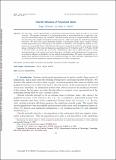Chordal Networks of Polynomial Ideals
Author(s)
Cifuentes, Diego Fernando; Parrilo, Pablo A.
DownloadPublished version (1.254Mb)
Terms of use
Metadata
Show full item recordAbstract
We introduce a novel representation of structured polynomial ideals, which we refer to as chordal networks. The sparsity structure of a polynomial system is often described by a graph that captures the interactions among the variables. Chordal networks provide a computationally convenient decomposition into simpler (triangular) polynomial sets, while preserving the underlying graphical structure. We show that many interesting families of polynomial ideals admit compact chordal network representations (of size linear in the number of variables), even though the number of components is exponentially large. Chordal networks can be computed for arbitrary polynomial systems using a refinement of the chordal elimination algorithm from [Cifuentes-Parrilo-2016]. Furthermore, they can be effectively used to obtain several properties of the variety, such as its dimension, cardinality, and equidimensional components, as well as an efficient probabilistic test for radical ideal membership. We apply our methods to examples from algebraic statistics and vector addition systems; for these instances, algorithms based on chordal networks outperform existing techniques by orders of magnitude. Key words. chordal graphs, structured polynomials, chordal networks, triangular sets
Date issued
2017-01Department
Massachusetts Institute of Technology. Laboratory for Information and Decision Systems; Massachusetts Institute of Technology. Department of Mathematics; Massachusetts Institute of Technology. Department of Electrical Engineering and Computer SciencePublisher
Society for Industrial & Applied Mathematics (SIAM)
Citation
Cifuentes, Diego, and Pablo A. Parrilo. “Chordal Networks of Polynomial Ideals.” SIAM Journal on Applied Algebra and Geometry 1, no. 1 (January 2017): 73–110. © 2017 Society for Industrial and Applied Mathematics
Version: Final published version
ISSN
2470-6566